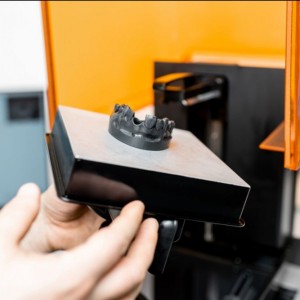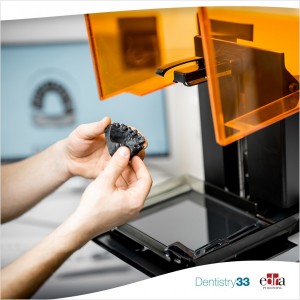
Traditional versus digital post and core fabrication: Which is more accurate?
Lara Figini
The conventional method for making an endocanal post and its abutment consists in taking the traditional impression with special pastes and using wax or acrylic resin to duplicate the root canal in its anatomy and create an "analog" post which will later be transformed into dental alloy after casting using the lost wax technique.
This technique has been considered the gold standard for constructing posts and cores for decades as it allows clinicians to obtain a framework that best adapts to the shape of the canal and provides good retention and support for the crowns. However, one of its shortcomings is that it creates some discrepancies which eventually can lead to loss of retention and catastrophic radical fracture.
Another way to make a post and abutment is to use a prefabricated metal post or a fiber post, reducing the number of clinical and laboratory steps. However, using a fiber post introduces other issues, such as the difficulty of achieving optimal adhesion and lack of strength. Recently, new methods have been proposed for making posts and abutments using digital technology. To date, few studies have investigated the accuracy of digitally fabricated pins by comparing them with those made with conventional techniques.
Materials and methods
In an in vitro study, published in the Journal of Prosthodontics, the authors compared the accuracy of root canal posts and the respective abutments created with three different processing techniques:
- conventional direct,
- with mechanical milling, and
- with three-dimensional (3D) printing.
Thirteen extracted single-root central incisors were selected for the study.
Root canal treatment and tooth preparation for the crown were performed on all teeth. The preparation of the 11 mm post housing was performed for a predetermined width and length standardized for all specimens.
Root canal impressions were made on all teeth using a polyvinylsiloxane impression material. Each impression was then scanned three-dimensionally using an extra-oral laboratory scanner. The scanned impressions were then processed using 3Shape CAD software. The digital designs of the posts and cores were used to fabricate 3D printed and milled posts and resin models for the cores.
The same teeth were used to fabricate the post and abutment with the conventional technique (direct duplication of the root canal with a resin model). All posts were then scanned before being cast using a metal-based alloy.
The post and abutments were scanned in several stages for digital volume measurement using Geomagic Control software to determine accuracy.
Results
These three core and post fabrication techniques have shown different results in the various fabrication steps. The accuracy of the 3D printed resin model (26.89±11.09 mm3) was found to be lower than the milled resin model (28.20±11.41 mm3, p = 0.0002).
However, the dimensional stability of the 3D printed resin model before and after casting (0.56±0.95 mm3) was found to be higher than the milled resin model (0.79±0.89 mm3) and direct resin (2.51±1.38 mm3, p = 0.00002).
All three techniques showed a significant volume reduction after adjustment (p = 0.0002).
In the final phase, the ground metal post and the respective abutment fabricated with the three different techniques did not show statistically significant differences in terms of accuracy (p = 0.15).
Conclusions
From the data of this study, it can be concluded that the digitally fabricated posts and abutments have the same degree of accuracy as those fabricated using the conventional technique.
For more information: "The accuracy of post and core fabricated with digital technology."
 Related articles
Related articles
News 27 August 2024
Draghici Dental Gains Market Edge with Chamlion’s Dental Metal 3D Printing Solutions
In the competitive world of dental technology, staying ahead means constantly innovating and optimizing.
Chamlion, a game-changing force in the digitalization of dentistry, is set to captivate attendees at the International Dental Equipment Exhibition (IDEX) 2024 in Turkey. With a comprehensive display...
Endodontics 04 December 2023
Root canal filling with 3D printing of teeth with internal perforating resorption
Internal root resorption originates from an inflammatory reaction, initiated by damage to the odontoblast layer and non-mineralized predentin, which results in exposure of mineralized dentin to the...
Medit Innovation Day 2023 is a free online event open to all dentists around the world. With the upcoming launch of the Medit ClinicCAD app, the company will offer a seamless dental CAD software that...
The market was estimated to be worth $7.2 billion in 2023 and is poised to reach $12.2 billion by 2028.
 Read more
Read more
Editorials 10 October 2025
With proud smiles and crisp white coats, ninety-three learners from the DDS Class of 2029 and the International Dentist Pathway Class of 2028 marked the start of their dental careers at the UCSF...
Periodontology 10 October 2025
Continuous professional development (CPD) in Periodontology refers to the overall framework of opportunities that facilitate a life-long learning practice, driven by the learner-practitioner and...
TheraBreath, the #1 alcohol-free mouthwash brand in the U.S.*, has introduced a new line of dentist-formulated, clinically tested toothpastes designed to support professional oral care...
News 10 October 2025
New officers and trustees were installed at the Minnesota Dental Association’s Leadership Conference on September 19 in Minneapolis.
News 10 October 2025
Smartee Denti-Technology today announced that Professor Gang Shen, its Chief Scientist and Executive President of TaiKang ByBo Dental, has once again been named to the World’s Top 2% Scientists...















